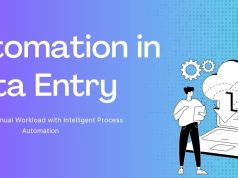In today’s digital -run business environment, data management has become the backbone of the organizational success. Whether you handle customer information, inventory, financial transactions or analytical data, the accuracy and efficiency of your data introduction procedures affect direct decision -making and operational skills.
Effective Data Management in Data Entry
According to research by Gartner, poor data quality costs organizations an average of $12.9 million annually. This staggering figure highlights the critical importance of implementing robust data management practices within your data entry workflows.
This comprehensive guide explores the fundamental principles, advanced strategies, and innovative tools that can transform your data entry operations from a potential vulnerability into a strategic asset.
Why Data Management Matters in Modern Data Entry
Data entry is far more than simply inputting information into systems. It’s the first critical step in the data lifecycle that determines data quality throughout your organization. With effective data management:
- Error rates decrease by up to 40%, according to the Data Management Association
- Decision-makers access reliable information for critical business choices
- Operational efficiency increases as teams spend less time correcting mistakes
- Regulatory compliance becomes significantly easier to maintain
- Customer satisfaction improves through accurate service delivery
A report from IBM indicates that businesses with strong data management practices are 178% more likely to outperform competitors in terms of revenue growth. This correlation between data quality and business performance cannot be overlooked.
The Hidden Costs of Poor Data Management in Data Entry
Before diving into best practices, it’s essential to understand what’s at stake. Ineffective data management in entry processes leads to:
Financial Impacts
- Data remediation costs: Fixing errors after they propagate through systems becomes exponentially more expensive
- Lost productivity: Teams waste valuable hours identifying and correcting mistakes
- Missed opportunities: Decisions based on flawed data lead to suboptimal outcomes
- Compliance penalties: Regulatory violations from inaccurate reporting can result in significant fines
Operational Challenges
- Process bottlenecks: Error correction creates workflow disruptions
- Decreased trust: Team members lose confidence in data-driven systems
- Customer dissatisfaction: Errors in customer-facing operations damage relationships
- Resource misallocation: Strategic initiatives receive inadequate funding based on flawed data
A McKinsey study found that organizations spend between 10-30% of revenue addressing data quality issues originating from entry errors. This represents an enormous opportunity cost that most businesses can ill afford.
7 Essential Data Management Principles for Data Entry Excellence
Achieving mastery in data management requires adherence to fundamental principles that govern how information is collected, processed, and maintained:
1. Data Governance Framework
Establish clear policies, procedures, and responsibilities for data management within data entry operations. This foundation ensures consistency across departments and provides accountability.
Key components include:
- Documented data entry standards
- Clearly defined roles and responsibilities
- Regular governance committee reviews
- Performance measurement protocols
2. Data Quality Metrics and Monitoring
You can’t improve what you don’t measure. Implement comprehensive metrics to track data quality throughout the entry process:
- Accuracy rate: Percentage of error-free records
- Completeness score: Measure of fields properly populated
- Timeliness index: Tracking of entry against deadline requirements
- Consistency rating: Evaluation of data conformity to established standards
3. Validation and Verification Processes
Implement multi-layered validation to catch errors at the earliest possible stage:
- Field-level validation: Ensure proper formats, ranges, and data types
- Record-level validation: Verify logical relationships between data elements
- Cross-reference verification: Compare against existing databases for consistency
- Outlier detection: Flag statistically improbable entries for review
4. Standardization and Normalization
Consistent formatting and organization dramatically reduce errors and improve usability:
- Standardized input formats (dates, addresses, phone numbers)
- Controlled vocabularies and dropdown selections where appropriate
- Normalization rules to eliminate redundancies
- Consistent handling of special characters and abbreviations
5. Data Security and Privacy Controls
Protect sensitive information throughout the data entry lifecycle:
- Role-based access control for data entry systems
- Encryption for sensitive data fields
- Audit trails for all data modifications
- Compliance with relevant regulations (GDPR, HIPAA, CCPA)
6. Training and Knowledge Management
Human factors remain critical in data entry excellence:
- Comprehensive onboarding for new data entry personnel
- Regular refresher training on system updates
- Knowledge base for handling edge cases
- Error pattern recognition training
7. Continuous Improvement Framework
Establish mechanisms for ongoing refinement of data management processes:
- Regular review of error patterns
- Feedback loops from data users to entry teams
- Scheduled process audits
- Technology assessment and upgrade planning
Advanced Data Entry Technologies for Superior Data Management
The technological landscape for data entry has evolved dramatically, offering powerful tools to enhance data management capabilities:
Optical Character Recognition (OCR) and Intelligent Document Processing
Modern OCR solutions have transformed data entry from physical documents:
- Accuracy rates exceeding 99% for clean documents
- Machine learning algorithms that improve with use
- Automatic field recognition and data extraction
- Integration with workflow management systems
According to AIIM Research, organizations implementing intelligent document processing see a 30-50% reduction in processing time and a 25-35% decrease in processing costs.
Data Entry Automation Tools
Beyond basic OCR, comprehensive automation solutions offer:
- Form field recognition and auto-population
- Data validation against multiple sources
- Exception handling workflows
- Integration with enterprise systems
AI and Machine Learning Enhancements
Artificial intelligence continues to revolutionize data entry management:
- Predictive entry that suggests likely values
- Pattern recognition for anomaly detection
- Natural language processing for unstructured data
- Continuous learning systems that adapt to organizational patterns
Implementing a Data Management Strategy for Data Entry Teams
Developing a coherent strategy requires careful planning and execution:
Assessment and Baseline Establishment
Begin by understanding your current state:
- Audit existing data entry processes
- Measure current error rates and processing times
- Identify pain points and bottlenecks
- Document compliance requirements and risks
Strategy Development and Roadmap Creation
With baseline data in hand, craft a comprehensive strategy:
- Define specific, measurable objectives
- Prioritize initiatives based on impact and feasibility
- Establish resource requirements and timelines
- Develop change management plans
- Create evaluation frameworks for measuring success
Technology Selection and Implementation
Choose solutions that align with your strategic goals:
- Develop detailed requirements documentation
- Evaluate vendor offerings against requirements
- Consider scalability, integration capabilities, and total cost of ownership
- Plan phased implementation to minimize disruption
- Establish robust testing protocols before full deployment
Process Optimization and Training
Technology alone isn’t enough—processes and people must evolve:
- Redesign workflows to leverage new capabilities
- Document standard operating procedures
- Develop comprehensive training materials
- Implement coaching and support mechanisms
- Establish feedback channels for continuous refinement
Best Practices for Day-to-Day Data Entry Management
Operational excellence requires attention to daily practices:
Data Entry Environment Optimization
- Ergonomic workstations to reduce fatigue
- Dual-monitor setups for reference material access
- Distraction-free zones for high-concentration tasks
- Regular breaks to maintain mental sharpness
Quality Control Checkpoints
- First-pass verification: Initial quality check immediately after entry
- Sampling protocols: Statistical quality control methods
- Peer review systems: Cross-checking of high-priority data
- Automated consistency checks: System-level validation rules
Documentation and Knowledge Management
- Easily accessible reference materials
- Searchable decision logs for handling edge cases
- Updated procedure documentation
- Centralized notification system for process changes
Team Performance Management
- Individual and team metrics balanced with quality measures
- Regular performance feedback
- Recognition programs for quality achievement
- Collaborative problem-solving sessions
Measuring Success: KPIs for Data Management in Data Entry
Effective measurement is essential for sustainable improvement:
Accuracy Metrics
- Error rate per 1,000 records: Industry benchmarks suggest aiming for <5 errors
- First-time accuracy percentage: Measure of records correct without rework
- Critical error tracking: Monitoring of high-impact mistakes
- Error pattern analysis: Identification of systematic issues
Efficiency Metrics
- Records processed per hour: Productivity measurement
- Processing cost per record: Financial efficiency indicator
- Turnaround time: Measurement from receipt to completion
- Automation percentage: Proportion of data processed without manual intervention
Process Health Indicators
- Exception handling rate: Percentage requiring special processing
- Backlog trends: Monitoring of processing queues
- System availability: Tracking of tool uptime
- Training completion: Measurement of staff preparedness
Future Trends in Data Management for Data Entry
The landscape continues to evolve rapidly:
Hyper-Automation
The integration of RPA, AI, machine learning, and process mining is creating end-to-end automation possibilities that dramatically reduce manual data entry requirements.
Voice-Driven Data Entry
Natural language processing advances are making voice-based data entry increasingly viable, with accuracy rates now comparable to manual entry in many contexts.
Edge Computing for Real-Time Validation
Distributed processing capabilities allow for immediate validation at the point of entry, reducing downstream errors and processing requirements.
Blockchain for Data Integrity
Immutable record systems are beginning to appear in high-security data entry environments, providing unprecedented traceability and audit capabilities.
Conclusion: Transforming Data Entry Through Strategic Management
Data management in data entry represents both a significant challenge and an enormous opportunity for modern organizations. By implementing the strategies outlined in this comprehensive guide, your organization can:
- Reduce costs associated with poor data quality
- Increase confidence in business intelligence
- Improve operational efficiency
- Enhance compliance posture
- Drive better decision-making through reliable information
The organizations that treat data entry not as a necessary evil but as a strategic advantage will be best positioned to thrive in our increasingly data-driven business landscape.
Remember that excellence in data management is not a destination but a journey of continuous improvement. By committing to the principles and practices outlined here, your organization can transform data entry from a vulnerability into a genuine competitive advantage.










